Icon theme by 91maan90
Download: Icon.p3t

The #1 spot for Playstation themes!
Beautiful Nature Silver Edition theme by Jewad Alnabi
Download: BeautifulNatureSE.p3t
Underwater theme by –Voldo–
Download: Underwater_2.p3t
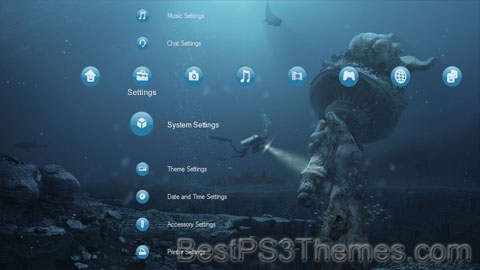
(1 background)
Redirect to:
Blue theme by Ru$$
Download: Blue_2.p3t
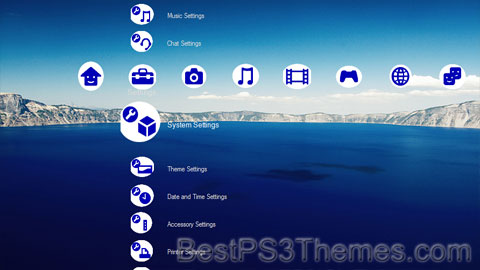
(3 backgrounds)
| Blue | |
|---|---|
Clockwise, from top left: A Ukrainian Police officer on duty; Tiles of the Sheikh Lotfollah Mosque, Iran; Red-legged honeycreeper; Copper(II) sulfate; Sea at the Marshall Islands; Planet Earth. | |
| Spectral coordinates | |
| Wavelength | approx. 450–495 nm |
| Frequency | ~670–610 THz |
| Hex triplet | #0000FF |
| sRGBB (r, g, b) | (0, 0, 255) |
| HSV (h, s, v) | (240°, 100%, 100%) |
| CIELChuv (L, C, h) | (32, 131, 266°) |
| Source | HTML/CSS[1] |
| B: Normalized to [0–255] (byte) H: Normalized to [0–100] (hundred) | |
Blue is one of the three primary colours in the RYB colour model (traditional colour theory), as well as in the RGB (additive) colour model.[2] It lies between violet and cyan on the spectrum of visible light. The term blue generally describes colours perceived by humans observing light with a dominant wavelength that’s between approximately 450 and 495 nanometres. Most blues contain a slight mixture of other colours; azure contains some green, while ultramarine contains some violet. The clear daytime sky and the deep sea appear blue because of an optical effect known as Rayleigh scattering. An optical effect called the Tyndall effect explains blue eyes. Distant objects appear more blue because of another optical effect called aerial perspective.
Blue has been an important colour in art and decoration since ancient times. The semi-precious stone lapis lazuli was used in ancient Egypt for jewellery and ornament and later, in the Renaissance, to make the pigment ultramarine, the most expensive of all pigments.[3] In the eighth century Chinese artists used cobalt blue to colour fine blue and white porcelain. In the Middle Ages, European artists used it in the windows of cathedrals. Europeans wore clothing coloured with the vegetable dye woad until it was replaced by the finer indigo from America. In the 19th century, synthetic blue dyes and pigments gradually replaced organic dyes and mineral pigments. Dark blue became a common colour for military uniforms and later, in the late 20th century, for business suits. Because blue has commonly been associated with harmony, it was chosen as the colour of the flags of the United Nations and the European Union.[4]
In the United States and Europe, blue is the colour that both men and women are most likely to choose as their favourite, with at least one recent survey showing the same across several other countries, including China, Malaysia, and Indonesia.[5][6] Past surveys in the US and Europe have found that blue is the colour most commonly associated with harmony, confidence, masculinity, knowledge, intelligence, calmness, distance, infinity, the imagination, cold, and sadness.[7]
The modern English word blue comes from Middle English bleu or blewe, from the Old French bleu, a word of Germanic origin, related to the Old High German word blao (meaning 'shimmering, lustrous').[8] In heraldry, the word azure is used for blue.[9]
In Russian, Spanish,[10] Mongolian, Irish, and some other languages, there is no single word for blue, but rather different words for light blue (голубой, goluboj; Celeste) and dark blue (синий, sinij; Azul) (see Colour term).
Several languages, including Japanese and Lakota Sioux, use the same word to describe blue and green. For example, in Vietnamese, the colour of both tree leaves and the sky is xanh. In Japanese, the word for blue (青, ao) is often used for colours that English speakers would refer to as green, such as the colour of a traffic signal meaning "go". In Lakota, the word tȟó is used for both blue and green, the two colours not being distinguished in older Lakota (for more on this subject, see Blue–green distinction in language).
Linguistic research indicates that languages do not begin by having a word for the colour blue.[11] Colour names often developed individually in natural languages, typically beginning with black and white (or dark and light), and then adding red, and only much later – usually as the last main category of colour accepted in a language – adding the colour blue, probably when blue pigments could be manufactured reliably in the culture using that language.[11]
The term blue generally describes colours perceived by humans observing light with a dominant wavelength between approximately 450 and 495 nanometres.[12] Blues with a higher frequency and thus a shorter wavelength gradually look more violet, while those with a lower frequency and a longer wavelength gradually appear more green. Purer blues are in the middle of this range, e.g., around 470 nanometres.
Isaac Newton included blue as one of the seven colours in his first description of the visible spectrum.[13] He chose seven colours because that was the number of notes in the musical scale, which he believed was related to the optical spectrum. He included indigo, the hue between blue and violet, as one of the separate colours, though today it is usually considered a hue of blue.[14]
In painting and traditional colour theory, blue is one of the three primary colours of pigments (red, yellow, blue), which can be mixed to form a wide gamut of colours. Red and blue mixed together form violet, blue and yellow together form green. Mixing all three primary colours together produces a dark brown. From the Renaissance onward, painters used this system to create their colours (see RYB colour model).
The RYB model was used for colour printing by Jacob Christoph Le Blon as early as 1725. Later, printers discovered that more accurate colours could be created by using combinations of cyan, magenta, yellow, and black ink, put onto separate inked plates and then overlaid one at a time onto paper. This method could produce almost all the colours in the spectrum with reasonable accuracy.
On the HSV colour wheel, the complement of blue is yellow; that is, a colour corresponding to an equal mixture of red and green light. On a colour wheel based on traditional colour theory (RYB) where blue was considered a primary colour, its complementary colour is considered to be orange (based on the Munsell colour wheel).[15]
In 1993, high-brightness blue LEDs were demonstrated by Shuji Nakamura of Nichia Corporation.[16][17][18] In parallel, Isamu Akasaki and Hiroshi Amano of Nagoya University were working on a new development which revolutionized LED lighting.[19][20]
Nakamura was awarded the 2006 Millennium Technology Prize for his invention.[21] Nakamura, Hiroshi Amano and Isamu Akasaki were awarded the Nobel Prize in Physics in 2014 for the invention of an efficient blue LED.[22]
Lasers emitting in the blue region of the spectrum became widely available to the public in 2010 with the release of inexpensive high-powered 445–447 nm laser diode technology.[23] Previously the blue wavelengths were accessible only through DPSS which are comparatively expensive and inefficient, but still widely used by scientists for applications including optogenetics, Raman spectroscopy, and particle image velocimetry, due to their superior beam quality.[24] Blue gas lasers are also still commonly used for holography, DNA sequencing, optical pumping, among other scientific and medical applications.

Blue is the colour of light between violet and cyan on the visible spectrum. Hues of blue include indigo and ultramarine, closer to violet; pure blue, without any mixture of other colours; Azure, which is a lighter shade of blue, similar to the colour of the sky; Cyan, which is midway in the spectrum between blue and green, and the other blue-greens such as turquoise, teal, and aquamarine.
Blue also varies in shade or tint; darker shades of blue contain black or grey, while lighter tints contain white. Darker shades of blue include ultramarine, cobalt blue, navy blue, and Prussian blue; while lighter tints include sky blue, azure, and Egyptian blue (for a more complete list see the List of colours).
In nature, many blue phenomena arise from structural colouration, the result of interference between reflections from two or more surfaces of thin films, combined with refraction as light enters and exits such films. The geometry then determines that at certain angles, the light reflected from both surfaces interferes constructively, while at other angles, the light interferes destructively. Diverse colours therefore appear despite the absence of colourants.[25]
Egyptian blue, the first artificial pigment, was produced in the third millennium BC in Ancient Egypt. It is produced by heating pulverized sand, copper, and natron. It was used in tomb paintings and funereal objects to protect the dead in their afterlife. Prior to the 1700s, blue colourants for artwork were mainly based on lapis lazuli and the related mineral ultramarine. A breakthrough occurred in 1709 when German druggist and pigment maker Johann Jacob Diesbach discovered Prussian blue. The new blue arose from experiments involving heating dried blood with iron sulphides and was initially called Berliner Blau. By 1710 it was being used by the French painter Antoine Watteau, and later his successor Nicolas Lancret. It became immensely popular for the manufacture of wallpaper, and in the 19th century was widely used by French impressionist painters.[26] Beginning in the 1820s, Prussian blue was imported into Japan through the port of Nagasaki. It was called bero-ai, or Berlin blue, and it became popular because it did not fade like traditional Japanese blue pigment, ai-gami, made from the dayflower. Prussian blue was used by both Hokusai, in his wave paintings, and Hiroshige.[27]
In 1799 a French chemist, Louis Jacques Thénard, made a synthetic cobalt blue pigment which became immensely popular with painters.
In 1824 the Societé pour l'Encouragement d'Industrie in France offered a prize for the invention of an artificial ultramarine which could rival the natural colour made from lapis lazuli. The prize was won in 1826 by a chemist named Jean Baptiste Guimet, but he refused to reveal the formula of his colour. In 1828, another scientist, Christian Gmelin then a professor of chemistry in Tübingen, found the process and published his formula. This was the beginning of new industry to manufacture artificial ultramarine, which eventually almost completely replaced the natural product.[28]
In 1878 German chemists synthesized indigo. This product rapidly replaced natural indigo, wiping out vast farms growing indigo. It is now the blue of blue jeans. As the pace of organic chemistry accelerated, a succession of synthetic blue dyes were discovered including Indanthrone blue, which had even greater resistance to fading during washing or in the sun, and copper phthalocyanine.


Blue dyes are organic compounds, both synthetic and natural.[30] Woad and true indigo were once used but since the early 1900s, all indigo is synthetic. Produced on an industrial scale, indigo is the blue of blue jeans.
For food, the triarylmethane dye Brilliant blue FCF is used for candies. The search continues for stable, natural blue dyes suitable for the food industry.[30]
Blue pigments were once produced from minerals, especially lapis lazuli and its close relative ultramarine. These minerals were crushed, ground into powder, and then mixed with a quick-drying binding agent, such as egg yolk (tempera painting); or with a slow-drying oil, such as linseed oil, for oil painting. Two inorganic but synthetic blue pigments are cerulean blue (primarily cobalt(II) stanate: Co2SnO4) and Prussian blue (milori blue: primarily Fe7(CN)18). The chromophore in blue glass and glazes is cobalt(II). Diverse cobalt(II) salts such as cobalt carbonate or cobalt(II) aluminate are mixed with the silica prior to firing. The cobalt occupies sites otherwise filled with silicon.
Methyl blue is the dominant blue pigment in inks used in pens.[31] Blueprinting involves the production of Prussian blue in situ.
Arab Republic of Egypt | |
|---|---|
| Anthem: "Bilady, Bilady, Bilady" "بلادي، بلادي، بلادي" (English: "My country, my country, my country") | |
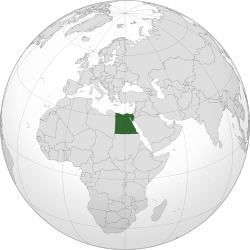 | |
| Capital and largest city | Cairo 30°2′N 31°13′E / 30.033°N 31.217°E |
| Official languages | Arabic[1] |
| National language | Egyptian Arabic[a] |
| Religion | See Religion in Egypt[b] |
| Demonym(s) | Egyptian |
| Government | Unitary semi-presidential republic under an authoritarian regime[6][7][8][9][10] |
| Abdel Fattah el-Sisi | |
| Mostafa Madbouly | |
| Legislature | Parliament |
| Senate | |
| House of Representatives | |
| Establishment | |
| c. 3150 BC | |
• Fall of Memphis | 343 BC |
| 639–642 | |
| 1171/4–1517 | |
• Muhammad Ali dynasty inaugurated | 9 July 1805[13] |
| 28 February 1922 | |
| 23 July 1952 | |
• Republic declared | 18 June 1953 |
| 18 January 2014 | |
| Area | |
• Total | 1,010,408[14][15] km2 (390,121 sq mi) (30th) |
• Water (%) | 0.632 |
| Population | |
• 2024[16] estimate | |
• 2017[17] census | |
• Density | 106.67/km2 (276.3/sq mi) (107th) |
| GDP (PPP) | 2024 estimate |
• Total | |
• Per capita | |
| GDP (nominal) | 2024 estimate |
• Total | |
• Per capita | |
| Gini (2017) | medium |
| HDI (2022) | high (105th) |
| Currency | Egyptian pound (LE/E£/£E) (EGP) |
| Time zone | UTC+2[c] (EGY) |
• Summer (DST) | UTC+3 |
| Driving side | right |
| Calling code | +20 |
| ISO 3166 code | EG |
| Internet TLD | |
Egypt (Arabic: مصر Miṣr [mesˁr], Egyptian Arabic pronunciation: [mɑsˤr]), officially the Arab Republic of Egypt, is a transcontinental country spanning the northeast corner of Africa and the Sinai Peninsula in the southwest corner of Asia. It is bordered by the Mediterranean Sea to the north, the Gaza Strip of Palestine and Israel to the northeast, the Red Sea to the east, Sudan to the south, and Libya to the west. The Gulf of Aqaba in the northeast separates Egypt from Jordan and Saudi Arabia. Cairo is the capital and largest city of Egypt, while Alexandria, the second-largest city, is an important industrial and tourist hub at the Mediterranean coast.[20] At approximately 100 million inhabitants, Egypt is the 14th-most populated country in the world, and the third-most populated in Africa.
Egypt has one of the longest histories of any country, tracing its heritage along the Nile Delta back to the 6th–4th millennia BCE. Considered a cradle of civilisation, Ancient Egypt saw some of the earliest developments of writing, agriculture, urbanisation, organised religion and central government.[21] Egypt was an early and important centre of Christianity, later adopting Islam from the seventh century onwards. Cairo became the capital of the Fatimid Caliphate in the tenth century, and of the Mamluk Sultanate in the 13th century. Egypt then became part of the Ottoman Empire in 1517, before its local ruler Muhammad Ali established modern Egypt as an autonomous Khedivate in 1867.
The country was then occupied by the British Empire and gained independence in 1922 as a monarchy. Following the 1952 revolution, Egypt declared itself a republic. For a brief period between 1958 and 1961 Egypt merged with Syria to form the United Arab Republic. Egypt fought several armed conflicts with Israel in 1948, 1956, 1967 and 1973, and occupied the Gaza Strip intermittently until 1967. In 1978, Egypt signed the Camp David Accords, which recognised Israel in exchange for its withdrawal from the occupied Sinai. After the Arab Spring, which led to the 2011 Egyptian revolution and overthrow of Hosni Mubarak, the country faced a protracted period of political unrest; this included the election in 2012 of a brief, short-lived Muslim Brotherhood-aligned Islamist government spearheaded by Mohamed Morsi, and its subsequent overthrow after mass protests in 2013.
Egypt's current government, a semi-presidential republic led by president Abdel Fattah el-Sisi since he was elected in 2014, has been described by a number of watchdogs as authoritarian and responsible for perpetuating the country's poor human rights record. Islam is the official religion of Egypt, and Arabic is its official language.[1] The great majority of its people live near the banks of the Nile River, an area of about 40,000 square kilometres (15,000 sq mi), where the only arable land is found. The large regions of the Sahara desert, which constitute most of Egypt's territory, are sparsely inhabited. About 43% of Egypt's residents live across the country's urban areas,[22] with most spread across the densely populated centres of greater Cairo, Alexandria and other major cities in the Nile Delta. Egypt is considered to be a regional power in North Africa, the Middle East and the Muslim world, and a middle power worldwide.[23] It is a developing country having a diversified economy, which is the largest in Africa, the 38th-largest economy by nominal GDP and 127th by nominal GDP per capita.[24] Egypt is a founding member of the United Nations, the Non-Aligned Movement, the Arab League, the African Union, Organisation of Islamic Cooperation, World Youth Forum, and a member of BRICS.
| |
Planets theme by JanoNath
Download: Planets_2.p3t
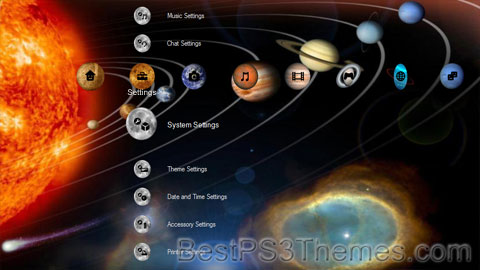
(1 background)
Redirect to:
This page is a redirect. The following categories are used to track and monitor this redirect:
|
Green theme by ltmreal
Download: Green.p3t
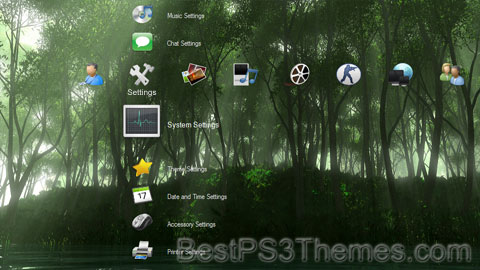
(4 backgrounds)
| Green | |
|---|---|
| Spectral coordinates | |
| Wavelength | 495–570 nm |
| Frequency | ~575–525 THz |
| Hex triplet | #00FF00 |
| sRGBB (r, g, b) | (0, 255, 0) |
| HSV (h, s, v) | (120°, 100%, 100%) |
| CIELChuv (L, C, h) | (88, 136, 128°) |
| Source | sRGB approximation to NCS S 2060-G[a] |
| B: Normalized to [0–255] (byte) H: Normalized to [0–100] (hundred) | |
Green is the color between cyan and yellow on the visible spectrum. It is evoked by light which has a dominant wavelength of roughly 495–570 nm. In subtractive color systems, used in painting and color printing, it is created by a combination of yellow and cyan; in the RGB color model, used on television and computer screens, it is one of the additive primary colors, along with red and blue, which are mixed in different combinations to create all other colors. By far the largest contributor to green in nature is chlorophyll, the chemical by which plants photosynthesize and convert sunlight into chemical energy. Many creatures have adapted to their green environments by taking on a green hue themselves as camouflage. Several minerals have a green color, including the emerald, which is colored green by its chromium content.
During post-classical and early modern Europe, green was the color commonly associated with wealth, merchants, bankers, and the gentry, while red was reserved for the nobility. For this reason, the costume of the Mona Lisa by Leonardo da Vinci and the benches in the British House of Commons are green while those in the House of Lords are red.[1] It also has a long historical tradition as the color of Ireland and of Gaelic culture. It is the historic color of Islam, representing the lush vegetation of Paradise. It was the color of the banner of Muhammad, and is found in the flags of nearly all Islamic countries.[2]
In surveys made in American, European, and Islamic countries, green is the color most commonly associated with nature, life, health, youth, spring, hope, and envy.[3] In the European Union and the United States, green is also sometimes associated with toxicity and poor health,[4] but in China and most of Asia, its associations are very positive, as the symbol of fertility and happiness.[3] Because of its association with nature, it is the color of the environmental movement. Political groups advocating environmental protection and social justice describe themselves as part of the Green movement, some naming themselves Green parties. This has led to similar campaigns in advertising, as companies have sold green, or environmentally friendly, products. Green is also the traditional color of safety and permission; a green light means go ahead, a green card permits permanent residence in the United States.

The word green comes from the Middle English and Old English word grene, which, like the German word grün, has the same root as the words grass and grow.[5] It is from a Common Germanic *gronja-, which is also reflected in Old Norse grænn, Old High German gruoni (but unattested in East Germanic), ultimately from a PIE root *ghre- "to grow", and root-cognate with grass and to grow.[6] The first recorded use of the word as a color term in Old English dates to ca. AD 700.[7]
Latin with viridis also has a genuine and widely used term for "green". Related to virere "to grow" and ver "spring", it gave rise to words in several Romance languages, French vert, Italian verde (and English vert, verdure etc.).[8] Likewise the Slavic languages with zelenъ. Ancient Greek also had a term for yellowish, pale green – χλωρός, chloros (cf. the color of chlorine), cognate with χλοερός "verdant" and χλόη "chloe, the green of new growth".
Thus, the languages mentioned above (Germanic, Romance, Slavic, Greek) have old terms for "green" which are derived from words for fresh, sprouting vegetation. However, comparative linguistics makes clear that these terms were coined independently, over the past few millennia, and there is no identifiable single Proto-Indo-European or word for "green". For example, the Slavic zelenъ is cognate with Sanskrit harithah "yellow, ochre, golden".[9] The Turkic languages also have jašɨl "green" or "yellowish green", compared to a Mongolian word for "meadow".[10]

In some languages, including old Chinese, Thai, old Japanese, and Vietnamese, the same word can mean either blue or green.[11] The Chinese character 青 (pronounced qīng in Mandarin, ao in Japanese, and thanh in Sino-Vietnamese) has a meaning that covers both blue and green; blue and green are traditionally considered shades of "青". In more contemporary terms, they are 藍 (lán, in Mandarin) and 綠 (lǜ, in Mandarin) respectively. Japanese also has two terms that refer specifically to the color green, 緑 (midori, which is derived from the classical Japanese descriptive verb midoru "to be in leaf, to flourish" in reference to trees) and グリーン (guriin, which is derived from the English word "green"). However, in Japan, although the traffic lights have the same colors as other countries have, the green light is described using the same word as for blue, aoi, because green is considered a shade of aoi; similarly, green variants of certain fruits and vegetables such as green apples, green shiso (as opposed to red apples and red shiso) will be described with the word aoi. Vietnamese uses a single word for both blue and green, xanh, with variants such as xanh da trời (azure, lit. "sky blue"), lam (blue), and lục (green; also xanh lá cây, lit. "leaf green").
"Green" in modern European languages corresponds to about 520–570 nm, but many historical and non-European languages make other choices, e.g. using a term for the range of ca. 450–530 nm ("blue/green") and another for ca. 530–590 nm ("green/yellow").[citation needed] In the comparative study of color terms in the world's languages, green is only found as a separate category in languages with the fully developed range of six colors (white, black, red, green, yellow, and blue), or more rarely in systems with five colors (white, red, yellow, green, and black/blue).[12][13] These languages have introduced supplementary vocabulary to denote "green", but these terms are recognizable as recent adoptions that are not in origin color terms (much like the English adjective orange being in origin not a color term but the name of a fruit). Thus, the Thai word เขียว kheīyw, besides meaning "green", also means "rank" and "smelly" and holds other unpleasant associations.[14]
The Celtic languages had a term for "blue/green/grey", Proto-Celtic *glasto-, which gave rise to Old Irish glas "green, grey" and to Welsh glas "blue". This word is cognate with the Ancient Greek γλαυκός "bluish green", contrasting with χλωρός "yellowish green" discussed above.

In modern Japanese, the term for green is 緑, while the old term for "blue/green", blue (青, Ao) now means "blue". But in certain contexts, green is still conventionally referred to as 青, as in blue traffic light (青信号, ao shingō) and blue leaves (青葉, aoba), reflecting the absence of blue-green distinction in old Japanese (more accurately, the traditional Japanese color terminology grouped some shades of green with blue, and others with yellow tones).
| Colour | Frequency (THz) |
Wavelength (nm) |
|---|---|---|
| 668–789 | 380–450 | |
| 610–668 | 450–490 | |
| 575–610 | 490–520 | |
green
|
526–575 | 520–570 |
| 508–526 | 570–590 | |
| 484–508 | 590–620 | |
| 400–484 | 620–770 | |
In optics, the perception of green is evoked by light having a spectrum dominated by energy with a wavelength of roughly 495–570 nm. The sensitivity of the dark-adapted human eye is greatest at about 507 nm, a blue-green color, while the light-adapted eye is most sensitive about 555 nm, a yellow-green; these are the peak locations of the rod and cone (scotopic and photopic, respectively) luminosity functions.[15]
The perception of greenness (in opposition to redness forming one of the opponent mechanisms in human color vision) is evoked by light which triggers the medium-wavelength M cone cells in the eye more than the long-wavelength L cones. Light which triggers this greenness response more than the yellowness or blueness of the other color opponent mechanism is called green. A green light source typically has a spectral power distribution dominated by energy with a wavelength of roughly 487–570 nm.[b]
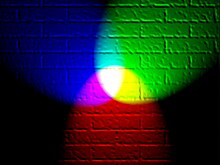
Human eyes have color receptors known as cone cells, of which there are three types. In some cases, one is missing or faulty, which can cause color blindness, including the common inability to distinguish red and yellow from green, known as deuteranopia or red-green color blindness.[17] Green is restful to the eye. Studies show that a green environment can reduce fatigue.[18]
In the subtractive color system, used in painting and color printing, green is created by a combination of yellow and blue, or yellow and cyan; in the RGB color model, used on television and computer screens, it is one of the additive primary colors, along with red and blue, which are mixed in different combinations to create all other colors. On the HSV color wheel, also known as the RGB color wheel, the complement of green is magenta; that is, a color corresponding to an equal mixture of red and blue light (one of the purples). On a traditional color wheel, based on subtractive color, the complementary color to green is considered to be red.[19]
In additive color devices such as computer displays and televisions, one of the primary light sources is typically a narrow-spectrum yellowish-green of dominant wavelength ~550 nm; this "green" primary is combined with an orangish-red "red" primary and a purplish-blue "blue" primary to produce any color in between – the RGB color model. A unique green (green appearing neither yellowish nor bluish) is produced on such a device by mixing light from the green primary with some light from the blue primary.
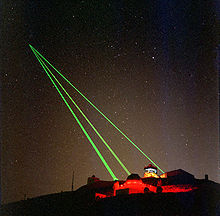
Lasers emitting in the green part of the spectrum are widely available to the general public in a wide range of output powers. Green laser pointers outputting at 532 nm (563.5 THz) are relatively inexpensive compared to other wavelengths of the same power, and are very popular due to their good beam quality and very high apparent brightness. The most common green lasers use diode pumped solid state (DPSS) technology to create the green light.[20] An infrared laser diode at 808 nm is used to pump a crystal of neodymium-doped yttrium vanadium oxide (Nd:YVO4) or neodymium-doped yttrium aluminium garnet (Nd:YAG) and induces it to emit 281.76 THz (1064 nm). This deeper infrared light is then passed through another crystal containing potassium, titanium and phosphorus (KTP), whose non-linear properties generate light at a frequency that is twice that of the incident beam (563.5 THz); in this case corresponding to the wavelength of 532 nm ("green").[21] Other green wavelengths are also available using DPSS technology ranging from 501 nm to 543 nm.[22] Green wavelengths are also available from gas lasers, including the helium–neon laser (543 nm), the Argon-ion laser (514 nm) and the Krypton-ion laser (521 nm and 531 nm), as well as liquid dye lasers. Green lasers have a wide variety of applications, including pointing, illumination, surgery, laser light shows, spectroscopy, interferometry, fluorescence, holography, machine vision, non-lethal weapons, and bird control.[23]
As of mid-2011, direct green laser diodes at 510 nm and 500 nm have become generally available,[24] although the price remains relatively prohibitive for widespread public use. The efficiency of these lasers (peak 3%)[citation needed] compared to that of DPSS green lasers (peak 35%)[citation needed][25] may also be limiting adoption of the diodes to niche uses.

Many minerals provide pigments which have been used in green paints and dyes over the centuries. Pigments, in this case, are minerals which reflect the color green, rather that emitting it through luminescent or phosphorescent qualities. The large number of green pigments makes it impossible to mention them all. Among the more notable green minerals, however is the emerald, which is colored green by trace amounts of chromium and sometimes vanadium.[26] Chromium(III) oxide (Cr2O3), is called chrome green, also called viridian or institutional green when used as a pigment.[27] For many years, the source of amazonite's color was a mystery. Widely thought to have been due to copper because copper compounds often have blue and green colors, the blue-green color is likely to be derived from small quantities of lead and water in the feldspar.[28] Copper is the source of the green color in malachite pigments, chemically known as basic copper(II) carbonate.[29]
Verdigris is made by placing a plate or blade of copper, brass or bronze, slightly warmed, into a vat of fermenting wine, leaving it there for several weeks, and then scraping off and drying the green powder that forms on the metal. The process of making verdigris was described in ancient times by Pliny. It was used by the Romans in the murals of Pompeii, and in Celtic medieval manuscripts as early as the 5th century AD. It produced a blue-green which no other pigment could imitate, but it had drawbacks: it was unstable, it could not resist dampness, it did not mix well with other colors, it could ruin other colors with which it came into contact, and it was toxic. Leonardo da Vinci, in his treatise on painting, warned artists not to use it. It was widely used in miniature paintings in Europe and Persia in the 16th and 17th centuries. Its use largely ended in the late 19th century, when it was replaced by the safer and more stable chrome green.[30] Viridian, as described above, was patented in 1859. It became popular with painters, since, unlike other synthetic greens, it was stable and not toxic. Vincent van Gogh used it, along with Prussian blue, to create a dark blue sky with a greenish tint in his painting Café Terrace at Night.[27]
Green earth is a natural pigment used since the time of the Roman Empire. It is composed of clay colored by iron oxide, magnesium, aluminum silicate, or potassium. Large deposits were found in the South of France near Nice, and in Italy around Verona, on Cyprus, and in Bohemia. The clay was crushed, washed to remove impurities, then powdered. It was sometimes called Green of Verona.[31]
Mixtures of oxidized cobalt and zinc were also used to create green paints as early as the 18th century.[32]
Cobalt green, sometimes known as Rinman's green or zinc green, is a translucent green pigment made by heating a mixture of cobalt (II) oxide and zinc oxide. Sven Rinman, a Swedish chemist, discovered this compound in 1780.[33] Green chrome oxide was a new synthetic green created by a chemist named Pannetier in Paris in about 1835. Emerald green was a synthetic deep green made in the 1
Safari Asphalt theme by ScorpionT16
Download: SafariAsphalt.p3t
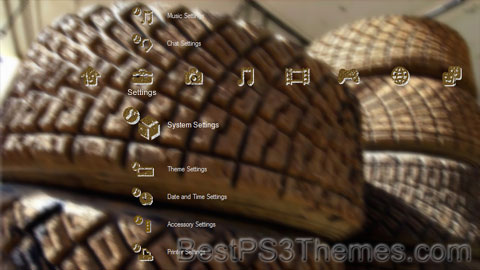
(1 background)
P3T Unpacker v0.12
Copyright (c) 2007. Anoop Menon
This program unpacks Playstation 3 Theme files (.p3t) so that you can touch-up an existing theme to your likings or use a certain wallpaper from it (as many themes have multiple). But remember, if you use content from another theme and release it, be sure to give credit!
Download for Windows: p3textractor.zip
Instructions:
Download p3textractor.zip from above. Extract the files to a folder with a program such as WinZip or WinRAR. Now there are multiple ways to extract the theme.
The first way is to simply open the p3t file with p3textractor.exe. If you don’t know how to do this, right click the p3t file and select Open With. Alternatively, open the p3t file and it will ask you to select a program to open with. Click Browse and find p3textractor.exe from where you previously extracted it to. It will open CMD and extract the theme to extracted.[filename]. After that, all you need to do for any future p3t files is open them and it will extract.
The second way is very simple. Just drag the p3t file to p3textractor.exe. It will open CMD and extract the theme to extracted.[filename].
For the third way, first put the p3t file you want to extract into the same folder as p3textractor.exe. Open CMD and browse to the folder with p3extractor.exe. Enter the following:
p3textractor filename.p3t [destination path]Replace filename with the name of the p3t file, and replace [destination path] with the name of the folder you want the files to be extracted to. A destination path is not required. By default it will extract to extracted.filename.